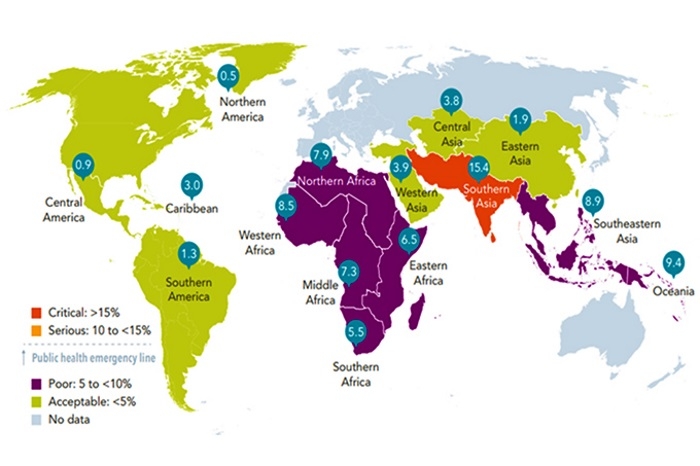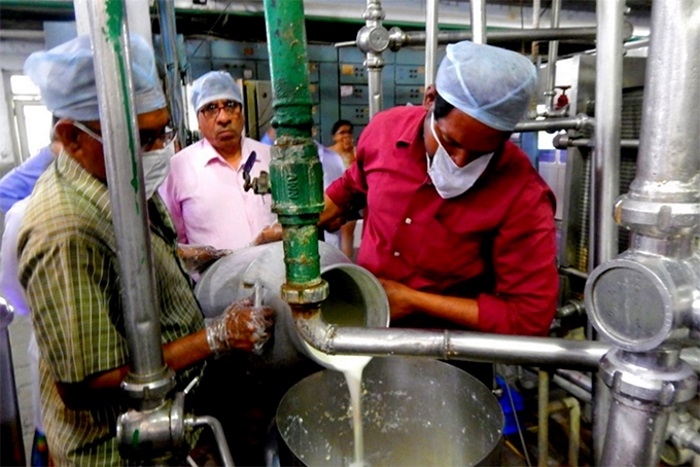Food Fortification: New way to cease hidden hunger

Hidden hunger or, Micronutrient deficiencies, occurs when the quality of food that people eat does not meet their nutrient requirements, so they are not getting the essential vitamins and minerals they need for their growth and development. In India only, 185 million people unable to get enough nutrients.
This hidden hunger is especially prominent among the children as more than 70% under five children are deficient in vitamin A and D, 57% of all children in the country don’t have adequate level of vitamin A.
Globally, more than two billion are deficient in key micro-nutrients, which are essential to their good health. These deficiencies have contributed to high level of stunting, wasting and under-weight children.

(Global micronutrient deficiency as a % of population)
The south Asia has most critical malnutrition.
The unavailability of micronutrients effects a balanced diet. So many time, accessible and affordable supplements taken in form of capsules or tablets can mitigate the symptoms of hidden hunger but, they can be hazardous if consumed in larger scale.
Unlike the supplements, FOOD FORTIFICATION is simple, preventive and low-cost approach to limit micronutrient deficiencies.
the World Health Organization (WHO) and the Food and Agricultural Organization of United State (FAO), Fortification refers to "the practice of deliberately increasing the content of an essential micronutrient like vitamins and minerals (including trace elements) in a food irrespective of whether the nutrients were originally in the food before processing or not, so as to improve the nutritional quality of the food supply and to provide a public health benefit with minimal risk to health", whereas enrichment is defined as "synonymous with fortification and refers to the addition of micronutrients to a food which are lost during processing”.
In India, iodine fortification of salt is only mandatory, but all other measures of fortification are missing in public health interventions in larger scale.
In 2016, FSSAI (Food Safety and Standard Authority of India) released standards for the fortification of five food items- rice, wheat, oil, salt and milk.
These regulations are now applied on fortified milk which is now available in varieties like low fat, skimmed and whole milk with vitamin A and D.But despite its significant health benefits, and rather than companies such as “Mother Dairy”, a subsidiary of the ‘National Dairy Development Board’ (NDDB), milk fortification is not yet common practice in across the Indian Milk industry.
To fill that gap, NDDB partnered in 2017 with the South Asia Food and Nutrition Security Initiative (SAFAI), the World Bank and Indian Nutrition Initiative, Tata Trusts to explore the possibilities of large-scale milk fortification in India. Over the last 12 months, this collaboration has enabled ten milk federations, dairy producer companies and milk unions across the country to pilot milk fortification for their consumers. Fifteen others have initiated.
The challenge remains to convert more milk in the unorganized sector to processed and packaged milk and eventually to fortified milk. Also, there are other variants of milk such as cow milk and full cream milk available in the market for which fortification standards are not yet in place.
The state of Jharkhand is one of the worst affected in India with acute vitamin A and D deficiencies.
Now, the Jharkhand Milk Federation is a pioneer in taking up milk fortification.

Even though India is the world’s largest dairy producer and one of the largest consumers of milk, only 35% to 40% of marketed milk pass through organized channels such as milk unions, dairy process companies and private sector.
The food fortification is only way to stop hidden hunger and malnutrition.